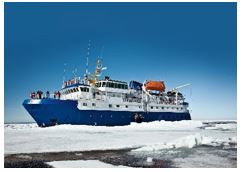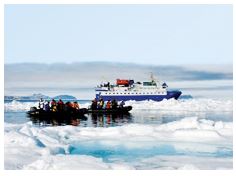Smith Myers to take part in Arctic ‘catastrophe exercise’ with international partners to demonstrate ARTEMIS airborne Search and Rescue technologies
Showcasing a range of SAR platforms including crewed and uncrewed aircraft, the disaster and resilience planning exercise LIVEX led by the innovation network ARCSAR (Arctic Security and Emergency Preparedness Network) will take place 28th August – 1st September outside of Svalbard, northern Norway. The PolarQuest expedition ship M/S Quest will embark on a cruise along the west side of Spitsbergen with 50 passengers and a crew of 25 people. The exercise will also take place in the waters outside of Longyearbyen.
Smith Myers – a member of the ARCSAR network – will demonstrate its award-winning ARTEMIS SAR line up based on detect and find features transforming mobile phones into location beacons for airborne search teams on board a Royal Norwegian Airforce SAR AW101 helicopter during a live exercise in Norway’s extreme northern coastal region. The exercise will showcase a range of technologies and applications including crewed and uncrewed aircraft.



Captions from left to right:
1. Smith Myers ARTEMIS detect and find technology is deployed by the Royal Norwegian Airforce on Search and Rescue duties with the Leonardo AW101 SAR Queen for service throughout Norway. ARTEMIS will play a significant role in the ARCAR Arctice exercise.
2. The PolarQuest expedition ship M/S Quest is to serve as a vessel in distress during the exercise LIVEX on Svalbard. (Photo: Helbild.se)
3. The disaster and resilience planning exercise LIVEX led by the innovation network ARCSAR (Arctic Security and Emergency Preparedness Network) will take place outside of Svalbard, northern Norway. (Photo: Arne Naevra)
According to Peter Myers, director at Smith Myers, who will be one of the passengers on the M/S Quest: “This exercise is exactly the environment ARTEMIS was designed for, the system employed by the Royal Norwegian Airforce for Search and Rescue duties with the Leonardo AW101 SAR Queen bears testament to our commitment to the region that experiences significant communications challenges. ARTEMIS can Detect, Locate and Communicate with phones even when there is no local cellular network coverage.
“The opportunity to not only demonstrate but share best practice with the spectrum of ARCSAR network partners, is an important part of the programme and we are committed to providing our game-changing technology globally.”
The idea behind the project is that cooperation is even more important in the face of security threats resulting from increased commercial activity in the region including ship traffic and offshore oil and gas activity. We share best practices and develop new practices within preparedness and safety at sea.
“During the exercise, we will also be testing out new technology in demanding Arctic environments. For example, we will be searching for missing persons by turning their mobile phone into a distress beacon, which is challenging in the High North with regards to local communications coverage,” explained Network partner Kevin Fitzgibbon, leader of HALPIN Centre for Research & Innovation, National Maritime College of Ireland (NMCI).
ARTEMIS turns any mobile phone into a rescue beacon, only requiring two small antennas to generate a latitude/longitude fix at ranges in excess of 30Km, offering a radical and effective alternative to traditional airborne sensors and direction-finding systems:
• Texting and calls in no service areas
• Automatic cueing of EO/IR (Electro -Optical/Infra-Red)
• Deployment as a stand-alone with embedded mapping or integrated with leading mission system providers
• Making missions in low light/ IMC (Instrument Meteorological Conditions) safer and increasing the odds for a positive outcome
• Available in several SWaP configurations for manned/unmanned platforms
The project is led by the Joint Rescue Coordination Centre in Northern Norway and the project consortium is comprised of 20 partners, including Smith Myers, from 12 countries.
The exercise activity on Svalbard is organized by the Icelandic Coast Guard, while the Norwegian Coast Guard and the Norwegian Air Force will be responsible for the evacuation with a ship and a SAR Queen-helicopter.
Other participants are the Governor of Svalbard, The Norwegian Coastal Administration, and the Association of Arctic Expedition Cruise Operators (AECO).
ARTEMIS has been in active service saving lives around the world and this year Smith Myers celebrates its 35th anniversary. The global customer base includes deployment with the Royal Norwegian Airforce for Search and Rescue duties with the Leonardo AW101 SAR Queen for service throughout Norway, and has received many international awards, including the coveted Royal Aeronautical Society Silver medal. Current area of interest includes Western and Eastern Europe, North America and Asia Pacific.
…. Ends
Note to Editors:
About Smith Myers: www.smithmyers.com
Smith Myers Communications Ltd is an award-winning UK company specialising in the design, development, manufacture and support of application specific cellular network and handset capabilities for Network Operators, Government Agencies, Law Enforcement, Military, and Search and Rescue organisations. Awards include Royal Aeronautical Society Silver Medal; ADS Security Innovation Awards, British Engineering Excellence Award, and ICCA (International Critical Communications) Award.
About The ARCSAR Network: www.arcsar.eu
The ARCSAR Network (Arctic Security and Emergency Preparedness Network) addresses the Arctic and North-Atlantic (ANA) region, preparing to cope with the security and safety threats that will result from increased commercial activity in the region including traffic through the northern passages, cruise traffic, and offshore oil and gas activity. Key challenges for Search and Rescue (SAR) operations in the ANA region include long distances, severe weather, ice and cold conditions, a poor communications network, lack of infrastructure and limited resources. Increased traffic on transpolar shipping routes expected in the near future, could prove a big challenge for the communications infrastructure. Communications satellites operating in geostationary Earth orbit do not cover the area of the Arctic. Even when a link can be made, it can be prone to interruption from icing on antennas, or from disruption caused by heavy seas.
For more information visit : https://www.smithmyers.com/ and https://www.artemis.smithmyers.com/
For commercial enquiries:
Contact: Andrew Munro, [email protected]
For editorial enquiries:
Contact: Philip Hicks, [email protected]
M: +44 (0) 7467 510339
16 August 2022 — SVALBAD, Norway —

